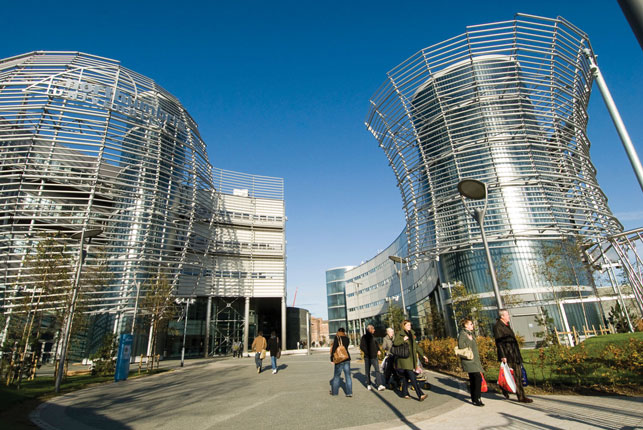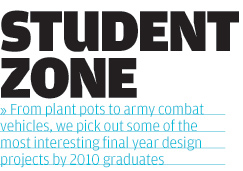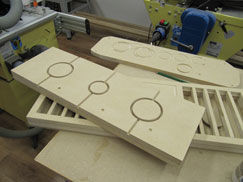Every year in the UK hundreds of product design students graduate and are catapulted into industry. Bright eyed and bushy tailed, the question is – has their university course sufficiently nurtured their talent, instilled them with the required skills and given them sufficient experience for designing in the real world?

Not your average university building: The new Design School building at Northumbria University
One student that strongly agrees is Louise Cochrane who is soon to graduate from her four-year Honours (Hons) Bachelor of Engineering (BEng) Product Design Engineering course at the University of Strathclyde. “I feel that my department – Design Manufacture and Engineering Management (DMEM) – has equipped me well with the knowledge and skills that enable me to work on any point of the design process whether designing initial concepts, optimising manufacturing processes or overseeing everything in a managerial role,” she explains.
Although Cochrane feels that she benefited from having engineering and manufacturing modules on her course there are many product design courses on offer at universities across the UK that have different focuses. For instance, prospective students can either choose a Bachelor of Arts (BA), Bachelor of Design (BDes), a Bachelor of Science (BSc) or, like Cochrane, a BEng and can do it over three or four years as an undergraduate, followed by a masters degree if desired.
Ryan McGinley, who also went to the University of Strathclyde, studied Bsc (Hons) Product Design & Innovation and decided to extend his studies through a 12-month intensive Masters course in Industrial Design at Northumbria University’s School of Design.
He puts his decision down to the School’s established reputation in design education. “I was looking at courses around the UK and then found Northumbria School of Design where the head of design at Apple, Pixar and the CEO of IDEO had all studied. After speaking to a few lecturers and reading the syllabus I knew where I wanted to do a Master in Design,” says McGinley.
McGinley has worked on a wide range of designs over the past year, on his own and with fellow students, on live projects for companies such as Polyphotonix, Massimo Dutti and Proctor & Gamble. All of the projects are born out of real design problems such as the ice hockey helmet he created for players who wear prescription glasses. “The inspiration came from watching two players on the Northumbria University team struggling with wearing glasses due to not being able to wear contact lenses,” he describes. “The problem then became more apparent when watching an opposing team who had three players who had resorted to wearing goggles. So, it was evident that this was a clear design problem.”
His design and development process, which follows a fairly standard route used in most professional design studios, started with ethnographic research in order to understand the key problems as well as research as to what was currently on the market. With this knowledge and also having carried out a focus group with the University ice hockey team, he worked in Photoshop and Illustrator Sketch to quickly mock up his visual ideas.
He decided that his final design would use prescription lenses in the form of glasses that form a visor when slotted into the helmet. He finally carried out 3D surface modelling in SolidWorks and used PhotoView 360 within SolidWorks to explore colour, material and finish.
During his course McGinley also benefited from the extensive resources and facilities available to students in the School of Design, which was rebuilt in 2007 as part of a £136 million development project in order to re-house and expand the existing School. The new facilities range from CAD suites that run software programmes including the standard Adobe suite, AutoCAD, Rhino, SolidWorks, Cinema 4D and Autodesk 3ds Max as well as extensive 3D prototyping workshops and construction facilities.
Many other universities offering product and industrial design courses are just as well equipped. For instance, the University of Strathclyde’s DMEM (Design, Manufacture & Engineering Management) department claims to host the only integrated physical, virtual and reverse engineering prototyping facility in the UK, whilst Nottingham Trent University’s (NTU) impressive professional-level facilities and workshops are equipped with the latest industry-standard technology such as a Flow Corporation CNC Water jet, a Dimension rapid prototype printer, two laser cutters and two 3-axis CNC wood routers.
These machines prove very useful to product design students in the prototyping stages of their projects. Students also benefit from a metalworking and timber machining workshop, an electronic workshop, a materials testing laboratory as well as five dedicated computing rooms, where there is access to a wide range of software including Adobe Photoshop CS2, AutoCAD, SolidWorks and Autodesk 3ds Max. “I would say that the workshop facilities available to us and the excellent advice and guidance from the workshop technicians has been one of the highlights of the course, especially in the final year,” explains final year BA Product Design student at NTU, John Etherington. “The technicians are all experienced and have backgrounds in manufacturing which has helped considerably in improving my ability to design for manufacture.”
What really attracted Etherington to NTU’s product design course was the 12-month industrial placement that takes place during the third year. “I chose NTU to study mainly due to its excellent connections and track record in placing students for a year in industry. This proved very useful for myself and a number of other students in securing a job after graduation as well as helping considerably with commercial awareness and design for manufacture throughout my final year,” confirms Etherington.
His placement at Bigblue Product Design, a Chester-based design consultancy which specialises in the retail and development of home cooking appliances, was an invaluable experience and as well as becoming more commercially aware it helped him enhance his presentation skills, gain experience in dealing with clients, suppliers and manufacturers as well as vastly improving his computing capabilities.
Etherington will start his permanent position at Bigblue in September 2010 and according to the consultancy’s managing director, Christopher Parker, he will be the third NTU student that the consultancy has taken on permanently following a work placement. “Taking a placement student gives us a trial run at integrating a new member into the team. If things work out we can always make a full time job for a good individual and will usually use that individual to head up a new area of business opportunity,” he says. “Additionally, we recognise that we have a responsibility to design education. We all got started somehow and we feel it’s important to give something back.”
Etherington’s final year project was inspired by his time at Bigblue and the consultancy’s desire to develop its own branded products – predominantly range and built-in cookers. So, the brief Etherington set himself was to design a prototype for a Bigblue branded built-in gas hob that could be included within this future range. He also wanted the hob to exhibit the consultancy’s values of elegance, simplicity, clarity and quality. “The hob is aimed at the high end user with special emphasis on contemporary aesthetics and showing the values of the company through its design,” explains Etherington. According to Parker, the hob system will undergo an assessment with a view to making it available for batch production at the premium end of the market.
In the initial stages of his project Etherington explains that he carried out a large amount of user research including motion mapping around the kitchen environment. From sketching he quickly moved into SolidWorks to model up his design and then sent these files to the laser cutters for the production of the prototypes. “I used the laser cutters at the University extensively when making scale prototypes of the initial ideas on the final designs,” he says.
With these prototypes he carried out anthropometric and ergonomic testing with potential users and the feedback helped in refining his design further. As well as SolidWorks he also utilised VRAY and Autodesk 3ds Max to produce photorealistic renderings of the 3D models throughout the design development phase of the project. The entire final design was then modelled in SolidWorks before manufacture of the final prototype commenced.
“Rapid prototyping machinery was used in the production of the final prototype to make the parts that would otherwise be injection moulded,” explains Etherington. Although the base of the prototype hob has been produced using slate, the final product will be constructed from glass ceramic. Additionally, all of the hob’s internal components were either constructed by Etherington or have been sourced from suppliers made during his placement year.
Although his course trained him for certain aspects of what work in a real life design studio would be like, of course it couldn’t prepare him completely. One area he felt he lacked skills in was CAD, “I think that tuition in 3D technologies is invaluable. I don’t think that we were taught it enough during the first and second years of university. This was realised during my placement at Bigblue where I found that the majority of the work undertaken was on computers for which I feel that I could have been better prepared,” he explains. “However, my computer skills, especially in the Adobe packages, improved considerably over my placement.”
Parker does not necessarily share Etherington’s views, “CAD skills are important to us but skills in a specific programme are less important than an understanding of the underlying principals and applications. SolidWorks can be picked up but time in an engineering workshop stays with you throughout a lifetime’s work.”
Cochrane’s view also differs from Etherington’s because although there is an opportunity at Strathclyde University to learn CAD during supervised classes, she found that the best way to learn was simply to use the software during her own time. “Being taught the basics in a structured way while at university certainly helps but for the most part I have taught myself,” she says. “I think it is really helpful to take any product that catches your eye, whether from your desk or in a magazine, and to try to use CAD to model it.” In fact, Cochrane did not use CAD much at all in her final year project – a portable flat-pack workstation made entirely from recycled fibreboard that enables nomadic workers to work virtually anywhere on their laptops.
“Due to the nature of my project I actually only used CAD for a short period of time during the product development,” she explains. “The stage at which I did use it was during the detail design and dimension refinement to create the final 2D net of the workstation that would be given to the manufacturers for the cutting and scoring of the workstation.”
No matter which product design course students graduate from, or what university they went to, they will never be completely prepared for design in the real world, but as long as they are eager to learn, are dedicated and show passion then they stand as good a chance as any, as Parker explains, “Students come to us in a semi-formed state, one could comment on inadequacies in any one area of knowledge such as engineering detailing, materials selection, project planning…the list goes on, it is however a willingness to engage in a continuing process of discovery and a developed approach towards creativity that is most useful to us.”
Although Etherington has already secured his place at Bigblue what of McGinley and Cochrane? Well, McGinley is currently looking for industrial design positions, however he is confident that what he has learnt so far – namely his ability to contribute decisively in multidisciplinary teams, find real design problems, and above all understand what clients really need in their business – will set him apart.
Meanwhile, Cochrane is off to Milan in September where she will be furthering her studies by undertaking the Product-Service-System Design course at the Politecnico di Milano. And when asked what makes her stand out from fellow design graduates she says rather enduringly, “Design isn’t just what I study; it is a genuine interest and passion in my everyday life. The main thing that I love about design is that everyone has an opinion on it and it touches the life of every single person. I may not be a doctor or a lawyer, but as a designer I too can change lives.”
Does a university degree prepare you for design in the real world?










